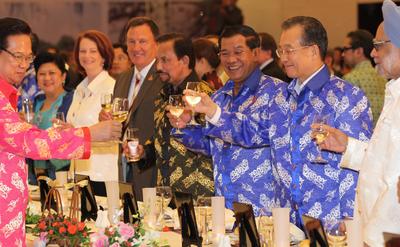East Asian countries have used integration to achieve goals beyond original financial mandates. Mechanisms like ASEAN+6 (EAS) have been used to involve extra-regional players as allies and counter-balance regional domination by any one participant, and to secure a wide range of extra governance and liberalisation benefits for East Asian countries.
As long as East Asian countries continue to benefit from the flexible character of these processes, there will continue to be a proliferation of multiple active integration/cooperation frameworks; a broad-ranging focus for active processes; and heavy involvement from extra-regional players.
After the Asian financial crisis, the region experienced rapid proliferation of integration and cooperation mechanisms. The pre-existing ASEAN, APEC, ARF and ASEM systems have been joined by ASEAN +3, SCO, BIMSTEC, IOR-ARC, ACD, EAS and ACMECS.
Free trade agreements (FTAs) have also proliferated in the region over the last decade as a method for achieving economic integration. Up until the end of the 1990s, the ASEAN Free Trade Area (AFTA) was the only notable development. By the end of 2010, however, about 50 (mainly bilateral) FTAs involving East Asian countries have come into effect and over 40 FTAs have been signed or negotiated, and there are around 15 FTAs being studied for feasibility.
Regional integration/cooperation mechanisms have become increasingly flexible and dynamic so as to serve the range of diverse policy preferences of East Asian countries. While most mechanisms were established to fulfil particular aims, such as facilitating security or financial cooperation, their practical functions have become increasingly broad and diverse.
FTAs, for instance, while ostensibly narrowly functional instruments, in the East Asian region reflect a wide range of policy preferences. Bilateral and multilateral mechanisms in the region often overlap in both function and membership, around a complex environment of co-existing objectives. Individual countries in the region are jostling to realise different benefits from the process of integration. Besides the obvious economic gains from increased trade and investment liberalisation, they also see potential in these mechanisms for increasing food, energy and resource security, and for national capacity building.
Developing countries hope to gain wider benefits, such as access to resources and legitimacy that can improve political and economic governance, and assistance in combating issues such as terrorism. Japan and China, on the other hand, are competing for regional leadership through these arrangements. Mainly through FTAs, they also compete in regional rule-setting in areas such as investment, anti-dumping and competition policy.
These mechanisms have become increasingly flexible in terms of membership as well as agenda-setting. These arrangements also involve countries outside the region, not as an exception but rather as a rule. Some of the most active ‘outsiders’ in this context are Australia, Chile, the EU, India, New Zealand, Peru, Russia and the United States.
East Asian countries are trying to balance the influence of participants and bolster their own interests through the involvement of similarly aligned external players. Chinese and Japanese competition for regional leadership has motivated other East Asian states to attempt to dilute the leadership of any one regional state through involvement of extra-regional partners such as India, Australia, New Zealand, and the EU in ASEAN+1 initiatives.
East Asian countries’ commitment to regional integration is thus rooted in a desire to achieve a wide range of diverse goals through a series of nominally narrow processes and mechanisms, and the ability to involve extra-regional allies as counter balances within the region.
East Asian countries cooperate and compete with each other to achieve multiple goals, and the flexible, multi-layered and inclusive nature of East Asian regional integration processes reflects and accommodates these policy preferences and goals closely. In short, East Asian integration is more likely to involve the continuing agglomeration of many frameworks and agreements, rather than the creation of a common ‘grand design’ for the future or any purposeful moving towards the realisation of that grand design, because that is what suits East Asia’s character and interests best.
Jiro Okamoto (PhD) is a Visiting Fellow at the Crawford School of Economics and Government at the ANU and an analyst of East Asian regionalism based in Canberra.

